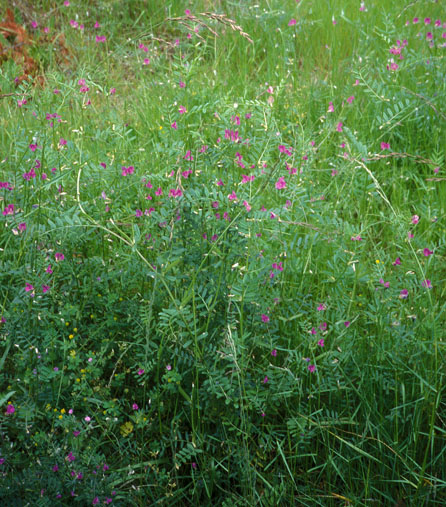
|
| Common Vetch; Vicia sativa L. |
Pea Family; LEGUMINOSÆ (FABACEÆ)
|
| "Vetch" is a name applied to certain species of the Pea Family. If life were as simple as some of us wish it was, all plants called
vetch would be in the genus Vicia, and no other plants would be called vetch. Alas, for simplicity: plants in at least five genera are so
called. However, the Common Vetch, Vicia sativa, is indeed our most abundant manifestation, though not as showy as some less common
species. It is the kind an ordinary garden usually has. Of course, seven other kinds of Vicia grow in Seattle, and some are almost as likely to
pop-up in cultivated soil. Most vetches grow in sunny meadows or grassy areas. |
| It's an annual herb of climbing habit, which is to say a weak little vine. From its root arise several angled stems, jointed,
scrambling, supporting themselves by grasping with their delicate leaf tendrils whatever comes within reach. The tendrils are tiny, threadlike, and
wrap tightly around the objects of their desire. The vetch leaves of 6 to 12 (16) leaflets are curiously nicked at the tips, in a manner
suggesting bluntness from a distance, but proving pointed close-up. The leaves fold-up at night. Pairs of purplish-pink flowers are borne in the
junctures of leaf and stem. Dark glands near these junctures attract ants. I cannot think of another common weed so likely to have ants, though
garden plants which usually or often support ants are: Douglas fir, apple trees, peonies, and wild pansy (heart's-ease). |
| Vetch flowers begin in May and continue a constant pace until the dry heat of summer and autumn stops them. You can find
some blooming in March or November, but the chief season is as I've said. Following the flowers are flattish, 2 to 3 inch long pods, first
green and tender, then drying brown-black; finally, spiraling apart in a burst, the shattered pods release their seeds. |
| This vetch has simple needs. It grows even on sterile dirt, though is at its exuberant best in rich soil, with plentiful sunshine.
Shade stunts vetch horribly. Nitrogen-fixing root swellings are easily viewed when you yank-up a vetch from the ground. Given good
conditions, a vetch plant luxuriates and sends forth numerous long stems in all directions, making a substantial mass of tangled vegetation. When
you weed-out such a vigorous plant, its tendrils sometimes break off and other times defiantly bring shredded bits of other plants with
them. Fortunately, vetch lacks the rank stinking odor of some other viny garden weeds such as Bittersweet Nightshade and Wild
Morning-Glory or Bindweed. |
| In late summer it shrivels up, and after winter's frosts there is only a faded brown memory of its twining stems' former lushness.
The seeds can sprout during any month, needing only the right amount of moisture to do so. It is not a serious pest because it's easily
controlled, and causes little damage anyway. Indeed, it is not invariably regarded as a mere weed. |
| Vetches grow in many parts of the earth. For example, two are native in Seattle. But
Vicia sativa is European and was intentionally brought to North America since it is so useful as a cover crop, green manure, and for pasturage and hay-making. It's especially
valuable in cool-weather areas. It's also called Spring or Pebble Vetch, Tare or Fitches, and is a cousin of peas, beans, clovers and alfalfa. The
Fava, Greek or Broad Bean is a robust very close relative, Vicia Faba. |
| I've rendered Common Vetch almost an endangered species in my own garden by eating it nearly to death! The growing tips are
an irresistible treat, good in texture, OK in flavor and superb as protein and nitrogen sources. Just pluck them raw, shake off the ants, and
eat them as is or in salads. Then, later, the tender young beans are also desirable eating, as are the seeds within. If you taste and like this
vetch, be heartened: some less common kinds are even better: the flowers of a few are sweet delicacies, and the bountiful merit of
Vicia nigricans ssp. gigantea is unparalleled. You will need, for safety's sake, to make positive identification before you eat because some
Lathyrus species are superficially vetch-like but deleterious to eat.
Lathyrus includes the Sweet Peas. |
The other wild vetches in Seattle are: V. americana (American Vetch), V. hirsuta (Tiny Vetch ), V. nigricans ssp. gigantea (Giant Vetch), V. sativa ssp. nigra (Narrowleaf Vetch), V. tetrasperma (Slender Vetch), and V. villosa (Woolly Vetch). Crown Vetch is Coronilla varia; it is an ornamental.
|
Originally published as the Seattle Tilth newsletter Weed of the Month in July 1990, along with an illustration drawn by Annie Figliola.
Back |
|
|

